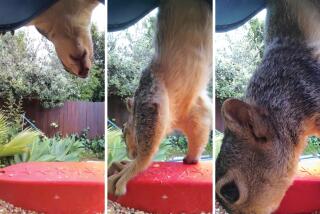Rattled Nerves : Venomous Snakes Shake Up Residents, Keep Animal-Control Officers Busy
Rattlesnakes, pushed by the drought and lured by the prospect of squirrels, rats and other tasty rodents, are slithering into yards and gardens in record numbers.
And itâs keeping animal-control officers busy.
âItâs unusual, the amount of rattlesnakes that weâre getting,â said John Rozier of the county Department of Animal Care and Control. âItâs way more.â
Over the past few weeks, animal shelters in Castaic and Lancaster have received a flood of calls from nervous residents reporting rattlesnakes. In Castaic, animal-control officers picked up 23 rattlers within a 19-day span that began June 1.
At the Antelope Valley shelter in Lancaster, more than a dozen rattlesnakes were captured within the same period. Several were of the Mojave Green variety, with venom more deadly than the more common Southern Pacific rattlesnake.
âIâve worked at both of these shelters off and on for 20 years, and Iâve never seen this many snakes,â Rozier said. âTheyâre getting them all over--not just in the foothills and the canyons. Theyâre getting them in the residential areas.â
The rattlers have struck up residences in woodpiles, ivy patches and compost heaps in search of the rodents that nest or scavenge there. In one instance, an alarmed father contacted animal-control officers when his 4-year-old son stumbled across a snake in the family garage, where the child had gone to fetch his tricycle.
Adriano Mattoni, a Mar Vista herpetologist, said the long-running drought has forced many snakes to gravitate to areas where prey is in greater abundance, often areas of human habitation. The heavy March rains may have contributed to a rise in the rodent population near settled communities, and the rattlers appear to have followed en masse.
âWeâve had a long dry spell, and the reptiles have been really hammered hard,â Mattoni said. âAnd mankind is encroaching farther and farther into these areas.
âThe rains have just made it a lot moister, which has brought a lot more snakes out. Theyâre wanting the rodents that are gyrating to where the people are.â
The rattlers, which sport distinctive diamond markings over bodies that can stretch as long as six feet, are the only indigenous venomous snakes in Southern California, Mattoni said. Upon encountering humans, the snakesâ first inclination is to slink away, but they will strike if suddenly disturbed or cornered.
A rattlesnake is equipped with special heat sensors that warn the near-blind reptile of the size and shape of the object confronting it. As it prepares to strike--often shaking its tail as a noisy prelude--the snake measures out its venom proportionately.
âBites into veins and arteries are lethal,â said Dr. Bob Galli, snakebite consultant for the Los Angeles County Medical Assn.âs Regional Poison Control Center. âSomeone could die as quickly as 10 minutes.â
But such cases are extremely rare. More often a person is bitten in soft tissue, as in the leg or hand, he said.
Swelling occurs almost immediately, followed by blood blisters as plasma leaks beneath the skin. The venom is so potent that victims can often watch the swelling âtravel upâ their extremities in a matter of minutes, Galli said.
Depending on the amount of venom and how long the bite goes untreated, victims may experience a tingling sensation around the mouth, twitching of the muscles, shortness of breath, clamminess of skin, dizziness, seizures and even death.
Although figures are hard to obtain, the mortality rate from snakebites is actually extremely low, Galli said. Of several thousand snakebite victims annually in the United States, fewer than 20 die.
âWe anticipate that thatâs because of the antivenin,â Galli said, referring to the serum developed to counter rattlesnake venom. âPeople are getting to hospitals, and we do have good treatment for them.â
In Los Angeles, Galli has handled about a dozen calls from doctors since the start of spring, including one whose patient experienced kidney failure and had to spend several days in an intensive-care unit. Four or five of the calls came this month.
Rattlers tend to be more active in spring and summer, hibernating during the winter. But Rozier of the Castaic animal shelter said the number of sightings and snakes caught so far this month is still higher than normal.
âWe have one field officer at night, and one night, he got four calls all at once,â Rozier recalled.
The captured rattlers are returned to the mountains and canyons, but in some cases, animal-control officers are forced to destroy them--usually after frightened residents have already injured the creatures with garden tools.
The best policy is simply to leave the snake alone and call the Department of Animal Care and Control, Rozier said.
âIf you go in your back yard and start working in the ivy, and you hear something rattling, just get out of the way.â
More to Read
Sign up for Essential California
The most important California stories and recommendations in your inbox every morning.
You may occasionally receive promotional content from the Los Angeles Times.











